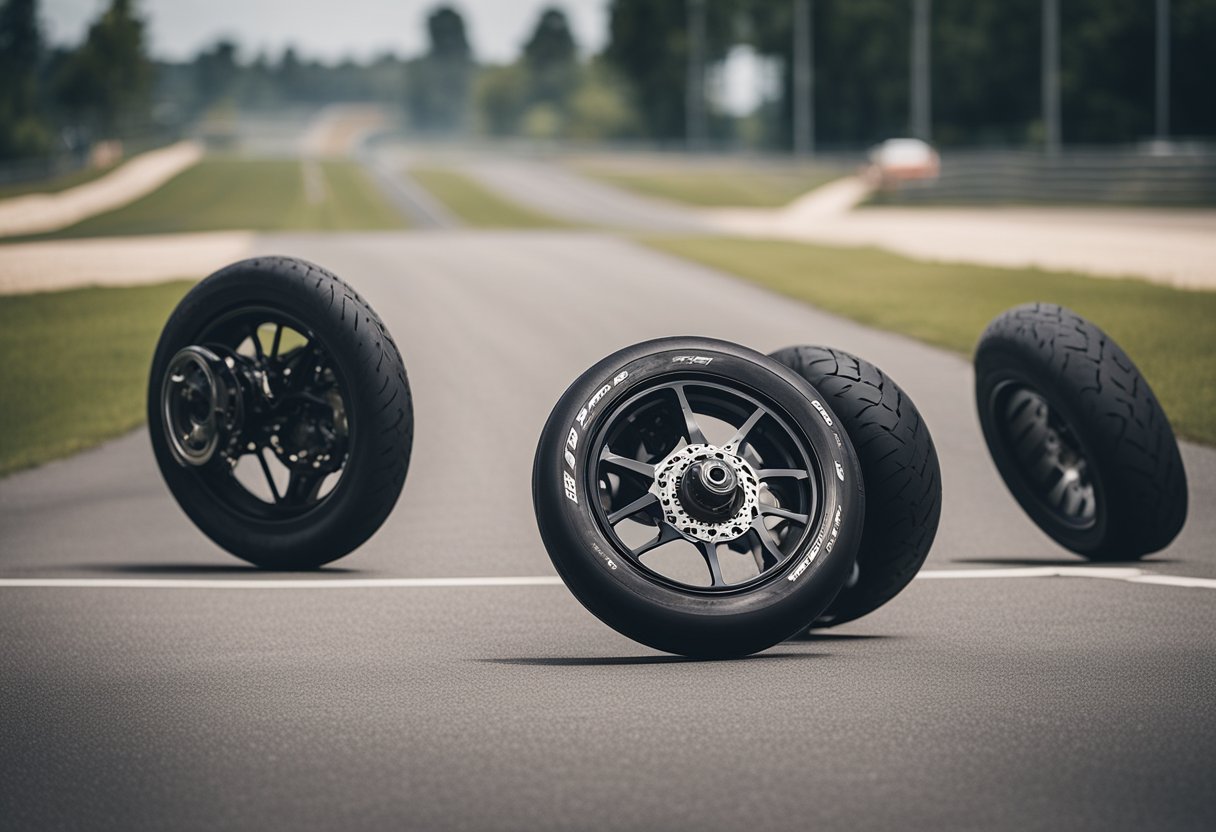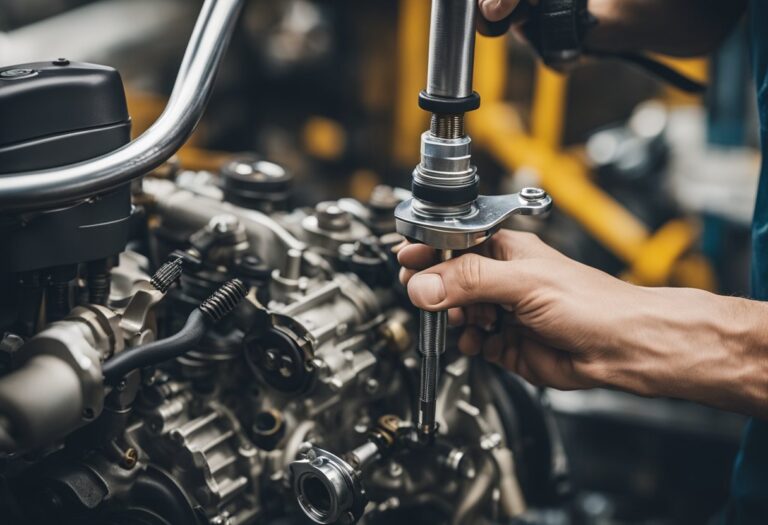How to Break In New Motorcycle Tires: A Clear Guide
Breaking in new motorcycle tires is a crucial step in ensuring optimal performance and safety on the road. It involves a process of gradually wearing down the surface of the tires to remove any mold-release agents and other contaminants that may affect their grip and handling. While it may seem like a tedious task, properly breaking in your new tires can significantly extend their lifespan and prevent accidents caused by poor handling.

Understanding Motorcycle Tire Break-In Before diving into the break-in process, it’s important to understand why it’s necessary. New tires come with a layer of mold-release agents that prevent them from sticking to the mold during production. These agents can also make the tires slippery and affect their grip on the road. By breaking in the tires, you’re essentially scrubbing off this layer to expose the rubber underneath, which provides better traction and handling.
Safety Precautions for New Tires While breaking in new tires is important, it’s equally crucial to do so safely. Riding on new tires can be unpredictable, especially during the first 100 miles or so. To minimize the risk of accidents, it’s recommended to avoid sudden acceleration, hard braking, and sharp turns during this period. It’s also important to ensure that the tires are properly inflated and that your motorcycle is in good condition before starting the break-in process.
Key Takeaways
- Properly breaking in new motorcycle tires can significantly extend their lifespan and improve their performance.
- The break-in process involves gradually wearing down the surface of the tires to remove mold-release agents and other contaminants that can affect their grip and handling.
- To break in new tires safely, it’s important to avoid sudden acceleration, hard braking, and sharp turns, and to ensure that the tires are properly inflated and your motorcycle is in good condition.
Understanding Motorcycle Tire Break-In

When it comes to breaking in new motorcycle tires, it’s important to understand the process and why it’s necessary. The break-in process is designed to help the tires achieve their maximum grip potential and longevity.
During the manufacturing process, a release agent is used to help remove the tire from the mold. This agent can leave a residue on the tire’s surface, which can affect its grip. Additionally, new tires tend to be slick and can have a hard surface, which can also affect their grip.
To properly break in new motorcycle tires, it’s recommended to follow the manufacturer’s guidelines. This typically involves riding at a reduced speed and avoiding hard acceleration, braking, and cornering for the first few hundred miles.
It’s also important to check the tire pressure regularly during the break-in period, as new tires can lose pressure more quickly than older tires.
By following the manufacturer’s guidelines for breaking in new motorcycle tires, riders can ensure that their tires will provide optimal grip and performance for the life of the tire.
Safety Precautions for New Tires

When breaking in new motorcycle tires, it is important to take certain safety precautions to ensure a safe and successful ride. Here are some tips to keep in mind:
1. Start Slowly
New tires are often slippery and require some time to properly adhere to the road surface. It is recommended to start slowly and gradually increase speed over the first few hundred miles. Avoid sudden acceleration or braking, and take turns at a moderate speed.
2. Avoid Wet Conditions
Wet roads can be particularly dangerous when breaking in new tires. The tires may not have had enough time to properly adhere to the surface, and the added moisture can make the surface even more slippery. Try to avoid riding in wet conditions until the tires have been properly broken in.
3. Check Tire Pressure
Proper tire pressure is crucial for safe riding. Be sure to check the tire pressure before each ride, especially during the break-in period. Follow the manufacturer’s recommended pressure, which can usually be found in the owner’s manual or on the tire itself.
4. Watch for Signs of Wear
During the break-in period, it is important to keep an eye out for any signs of wear or damage to the tires. Check for any cuts, punctures, or bulges, as well as any unusual wear patterns. If you notice anything out of the ordinary, have the tires inspected by a professional.
By following these safety precautions, riders can ensure a safe and successful break-in period for their new motorcycle tires.
Initial Inspection and Preparation

Before breaking in new motorcycle tires, it is important to conduct an initial inspection and preparation to ensure that the tires are in good condition and ready for use.
Firstly, inspect the tires for any visible damage such as cuts, punctures, or bulges. If any damage is found, the tires should be replaced immediately.
Next, check the tire pressure and adjust it to the recommended level specified in the owner’s manual. It is important to note that the tire pressure should be checked when the tires are cold, as the pressure can increase when the tires are warm.
After checking the tire pressure, it is recommended to clean the tires with soap and water to remove any dirt or debris that may have accumulated during storage or transportation.
Once the tires are clean, it is important to ensure that the wheels are properly balanced. Unbalanced wheels can cause uneven tire wear and affect the handling of the motorcycle.
In summary, conducting an initial inspection and preparation is essential to ensure that new motorcycle tires are in good condition and ready for use. By following these steps, riders can ensure that their tires are safe and will perform optimally during the break-in period.
The Break-In Process

First Ride Considerations
Before hitting the road, it’s important to consider a few things for the first ride on new motorcycle tires. First, ensure that the tires are properly inflated according to the manufacturer’s recommendations. This will ensure that the tires perform as intended and reduce the risk of damage.
Next, take it slow and easy for the first few miles. This will allow the tires to warm up gradually and reduce the risk of slipping or sliding. Avoid sudden acceleration, hard braking, or sharp turns during this initial period.
Mileage Guidelines
Most manufacturers recommend a break-in period of around 100-200 miles for new motorcycle tires. During this period, it’s important to avoid high speeds and aggressive riding. This will allow the tires to wear evenly and settle into their intended shape.
After the break-in period, it’s still important to monitor the tires for wear and tear. Regularly inspect the tires for any signs of damage or uneven wear, and replace them if necessary.
Speed and Handling During Break-In
During the break-in period, it’s important to avoid high speeds and aggressive riding. This will allow the tires to wear evenly and settle into their intended shape. Gradually increase your speed and cornering as you become more comfortable with the tires.
It’s also important to avoid prolonged periods of high speed or hard braking during the break-in period. This can cause excessive heat buildup and premature wear on the tires.
By following these guidelines, you can ensure that your new motorcycle tires break in properly and provide reliable performance for miles to come.
Post-Break-In Inspection

After the break-in period, it is important to inspect the motorcycle’s tires to ensure they are in good condition and ready for regular use. Here are some key areas to check:
Tire Pressure
Check the tire pressure using a reliable gauge and adjust it to the manufacturer’s recommended level. This information can be found in the owner’s manual or on a sticker located on the motorcycle’s frame. Proper tire pressure is crucial for safety and optimal performance.
Tread Depth
Inspect the tread depth of the tires using a tread depth gauge. The minimum legal tread depth is 1.6mm, but it is recommended to replace the tires once the tread depth reaches 2mm. Worn-out tires can affect handling, traction, and braking performance.
Sidewall Damage
Check the sidewalls of the tires for any signs of damage, such as cuts, punctures, or bulges. These can weaken the tire’s structure and increase the risk of a blowout. If any damage is found, the tire should be replaced immediately.
Wheel Alignment
Inspect the wheel alignment to ensure that the tires are properly aligned with each other and the motorcycle’s frame. Misaligned wheels can cause uneven wear and affect handling and stability. A professional mechanic should perform this inspection.
By following these post-break-in inspection tips, riders can ensure their motorcycle’s tires are in top condition and ready for safe and enjoyable riding.
Maintenance Tips for Newly Broken-In Tires

Once you have successfully broken in your new motorcycle tires, it is important to maintain them properly to ensure optimal performance and longevity. Here are some maintenance tips to keep your tires in top shape:
- Check tire pressure regularly: Maintaining the correct tire pressure is crucial for safety and performance. Check the tire pressure at least once a week and adjust it if necessary. Always use a reliable tire pressure gauge and follow the manufacturer’s recommendations for the correct pressure.
- Inspect tires for damage: Regularly inspect your tires for any signs of damage, such as cuts, punctures, or bulges. If you notice any damage, replace the tire immediately. Riding on damaged tires can be dangerous and could lead to a blowout.
- Rotate tires regularly: Rotating your tires can help to ensure even wear and extend their lifespan. Follow the manufacturer’s recommendations for tire rotation, which may vary depending on the type of tire and your riding habits.
- Avoid harsh chemicals: Avoid using harsh chemicals or solvents on your tires, as they can damage the rubber and reduce the tire’s lifespan. Use a mild soap and water to clean your tires, and avoid using abrasive brushes or cleaning tools.
- Store tires properly: If you need to store your motorcycle for an extended period, it is important to store the tires properly to prevent damage. Store the bike in a cool, dry place away from direct sunlight, and avoid placing heavy objects on the tires.
By following these maintenance tips, you can help to ensure that your newly broken-in motorcycle tires perform well and last for as long as possible.
Common Mistakes to Avoid

When breaking in new motorcycle tires, there are some common mistakes that riders should avoid to ensure optimal performance and safety.
Overloading the Bike
One of the most common mistakes that riders make when breaking in new motorcycle tires is overloading the bike. Overloading the bike can cause excessive wear on the tires and lead to poor handling and reduced performance. It is important to check the manufacturer’s recommended weight limit and ensure that the bike is not overloaded.
Riding Too Aggressively
Another mistake that riders make when breaking in new motorcycle tires is riding too aggressively. This can cause excessive wear on the tires and reduce their lifespan. It is important to ride at a moderate pace and avoid sudden acceleration or hard braking during the break-in period.
Neglecting Tire Pressure
Neglecting tire pressure is another common mistake that riders make when breaking in new motorcycle tires. It is important to check the tire pressure regularly and ensure that it is within the manufacturer’s recommended range. Improper tire pressure can lead to poor handling, reduced performance, and increased wear on the tires.
Skipping the Break-In Period
Finally, one of the most common mistakes that riders make when breaking in new motorcycle tires is skipping the break-in period altogether. The break-in period is essential for ensuring optimal performance and safety of the tires. It is important to follow the manufacturer’s recommended break-in procedure and avoid pushing the tires too hard during the first few hundred miles.
By avoiding these common mistakes, riders can ensure that their new motorcycle tires are broken in properly and perform optimally for years to come.





